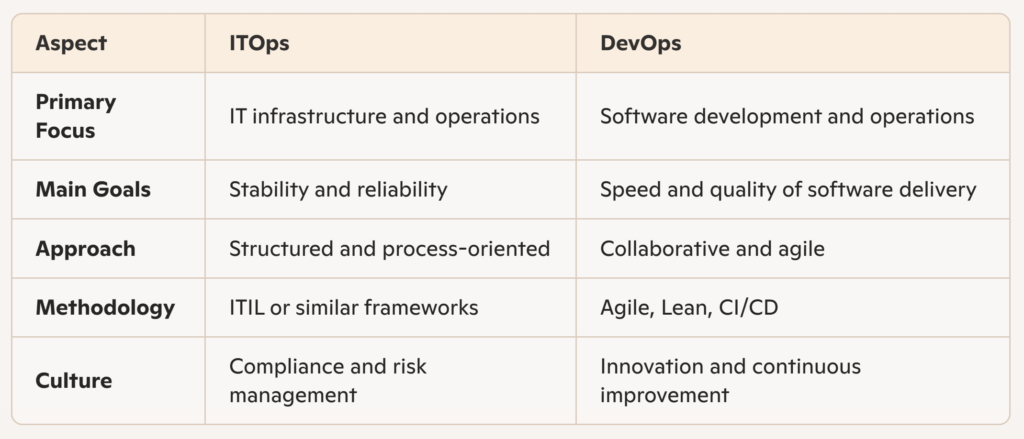ITOps (IT Operations) and DevOps (Development Operations) are two distinct approaches to managing and delivering IT services and applications. Here are the key differences between them:
ITOps (IT Operations)
1. Focus:
– Primarily focuses on maintaining and managing the IT infrastructure, including servers, networks, and storage.
– Ensures the availability, performance, and security of IT services.
2. Responsibilities:
– Monitoring and managing hardware and software.
– Performing routine maintenance and updates.
– Incident and problem management.
– Capacity planning and performance tuning.
3. Goals:
– Ensure stability, reliability, and security of IT systems.
– Minimize downtime and ensure business continuity.
4. Process:
– Typically follows ITIL (Information Technology Infrastructure Library) or similar frameworks.
– Emphasizes formal procedures, documentation, and risk management.
5. Culture:
– More structured and process-oriented.
– Focus on compliance and minimizing risks.
DevOps (Development Operations)
1. Focus:
– Bridges the gap between software development and IT operations.
– Aims to improve collaboration, communication, and integration between development and operations teams.
2. Responsibilities:
– Automating the software development lifecycle (SDLC).
– Continuous integration and continuous delivery (CI/CD).
– Infrastructure as code (IaC).
– Monitoring and feedback loops.
3. Goals:
– Accelerate software delivery and deployment.
– Enhance the quality and reliability of software releases.
– Foster a culture of continuous improvement and innovation.
4. Process:
– Utilizes agile and lean methodologies.
– Emphasizes automation, collaboration, and iterative development.
5. Culture:
– Collaborative and flexible.
– Focus on innovation, speed, and improving the end-to-end delivery process.
Key Differences:

In essence, while ITOps ensures the stability and performance of IT services, DevOps aims to improve the speed and quality of software development and delivery through enhanced collaboration and automation. Both are critical for the overall success of an organization’s IT strategy.
